notice:
Search:
Classroom acoustic design scheme

admin
Acoustic PET Felt Panels Factory | Akupanel & Acoustic Wall Panels Manufacturer - Guangdong Yuefa Acoustic New Materials Co., Ltd
Classroom acoustic design scheme
Classroom acoustic design is an extremely important part of the educational environment, which directly affects the learning effectiveness of students and the teaching quality of teachers.
A good acoustic design scheme can effectively improve the acoustic environment of the classroom, enhance the listening effect and focus of students, and also enhance the sound transmission effect of teachers, making teaching more vivid and effective.
Firstly, there are many factors that need to be considered in classroom acoustic design, including the size, shape, materials, and furniture placement of the classroom.
When designing a classroom acoustic scheme, it is necessary to fully consider these factors to ensure the effectiveness and feasibility of the acoustic design scheme.
In addition, it is necessary to consider the functional requirements of the classroom, such as the need for multimedia teaching, music performances, etc., which will have an impact on the acoustic design scheme.
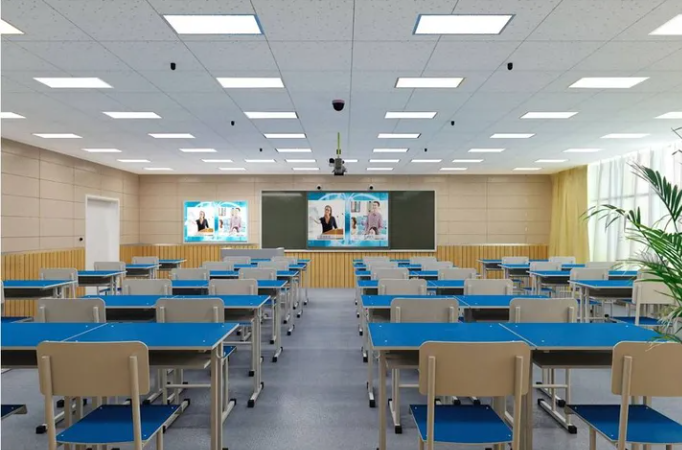
Common acoustic defects in classrooms
(1) Excessive reverberation time
Reverberation time is the most important factor affecting the classroom sound environment, and appropriate reverberation time can make the information received by students clear and accurate,
Excessive reverberation time reduces language clarity, affects students' reception and understanding of information, leads to distraction, and reduces learning efficiency.
At present, the walls and ceilings of most classrooms have a large white surface, and the floor is covered with ceramic tiles. These types of walls are relatively hard, with strong sound reflection, and their sound absorption coefficient is generally only 0.01-0.05.
The curtains are ordinary fabric curtains with a low sound absorption coefficient. Large space and strong reflection result in a long reverberation time, usually above 1.3 seconds.
As shown in Table 1, the volumes given by different countries in 200m ³ The recommended values for indoor reverberation time in the following classrooms are:

教室作为语言交流场所,其听闻环境最直接的评价参量是语言清晰度。
结果表明:在高信噪比条件下,体积不超过200m³的教室中频混响时间控制在0.6s左右室内听闻效果最佳。

Secondly, the acoustic design scheme needs to consider the propagation of sound at different frequencies in the classroom.
Generally speaking, low-frequency sound is prone to resonate in the classroom, while high-frequency sound is prone to reflection.
Therefore, corresponding measures need to be taken in acoustic design schemes, such as using sound-absorbing materials to reduce resonance, using acoustic panels to reduce reflection, etc., to ensure that the acoustic environment in the classroom meets the requirements of learning and teaching.
In addition, the classroom acoustic design scheme also needs to consider the noise control inside the classroom.
In modern society, noise pollution has become a serious problem, and classrooms, as places for learning and teaching, need to maintain a relatively quiet environment.
Therefore, in acoustic design schemes, it is necessary to consider how to reduce external and internal noise, such as using soundproofing materials, installing soundproofing windows, etc., to ensure a quiet environment in the classroom.
Acoustic design basis
Design and testing methods and technical standards:
a. GB/T 50121-2005 "Evaluation Standard for Building Sound Insulation"
b. GB/50118-2010 "Code for Design of Sound Insulation in Civil Buildings"
c. GB/50352-2005 General Principles for Design of Civil Buildings
d. GB/T 50356-2005 "Code for acoustic design of theaters, cinemas, and multi-purpose halls"
e. GB/T19889.5-2005 "Acoustics - Measurement of sound insulation in buildings and building components - Part 5: On site measurement of air sound insulation in exterior wall components"
f. GB/T19889.4-2005 "Acoustics - Measurement of sound insulation in buildings and building components - Part 4: Field measurement of airborne sound insulation between rooms"
The definition of acoustics referred to here is:
• Noise control (sound insulation)
Vibration control (isolation)
Indoor sound field (Jiansheng)
Classroom acoustic design scheme
1、 Indoor Sound Field Design
To ensure sufficient sound level and appropriate reverberation time in the classroom (around 0.6 seconds for small classrooms and 1 second for classrooms with 500 people), the volume of each classroom and lecture hall should not exceed 3-3.5 meters ³。 Focus on designing the following indicators:
1. Appropriate reverberation time
2. Sufficient loudness to ensure that a moderate amount of sound can be heard at various locations indoors
3. The indoor sound field should be uniform, and the unevenness of the sound field should be within ± 4dB.
4. No obvious acoustic defects.
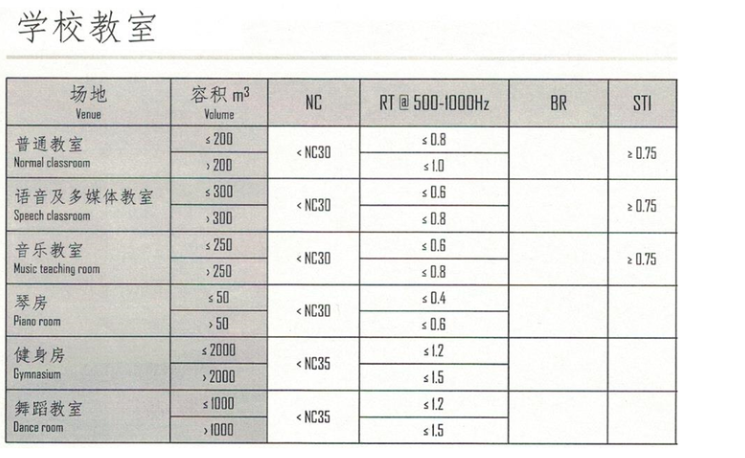
(1) Reverberation time control
The classroom is an acoustic space mainly focused on language, so the clarity of language is very important.
The clarity of language is related to the length of reverberation time and the magnitude of loudness. When the loudness is constant, the shorter the reverberation time, the higher the clarity.
But the reverberation time is too short and the sound lacks fullness, so generally speaking, we control the mid frequency reverberation time of small and medium-sized classrooms to about 0.6 seconds.
Reverberation time of 500Hz-1000Hz in various classroom empty spaces
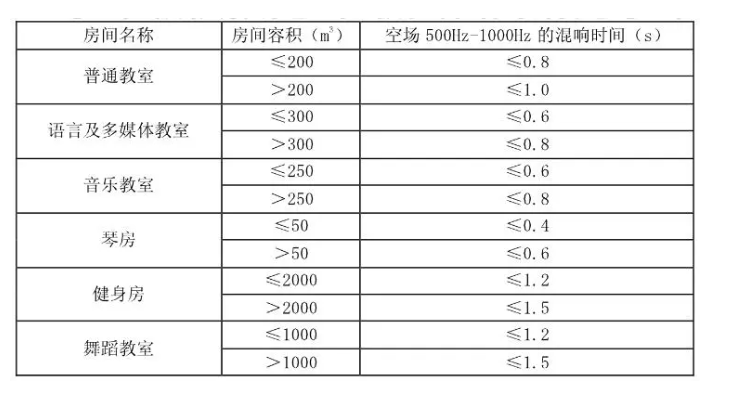
When the volume is constant, the length of reverberation time is inversely proportional to the total indoor sound absorption. So we need to increase the total indoor sound absorption to achieve the goal of reducing reverberation time.
A typical classroom can use sound-absorbing materials such as wooden perforated sound-absorbing boards, polyester fiber sound-absorbing boards, and perforated gypsum boards. At the same time, materials such as sound-absorbing curtains, sound-absorbing decorative paintings, and sound-absorbing pendants can be used to increase sound absorption.
For staircase classrooms, strong sound-absorbing materials such as AGG sand absorbing boards, fiberglass boards, or wood fiber boards can be used at the back end to avoid acoustic defects.
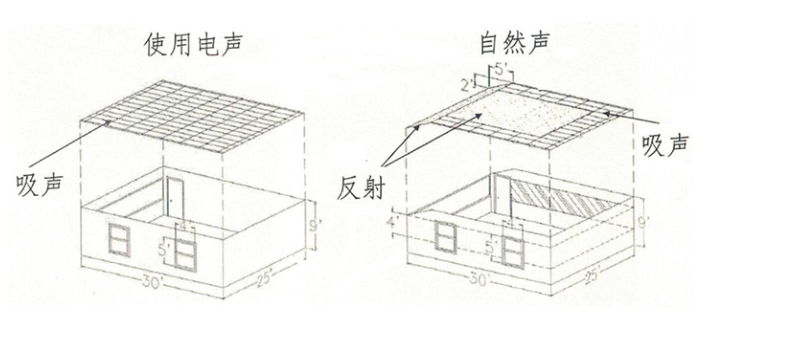
(2) Design of Sound Field Uniformity
1. The main issue with classroom sound field uniformity is the difference in sound pressure levels between the front and rear rows. It is necessary to fully utilize the early reflected sound transmitted from the ceiling and side walls to improve the rear row loudness, and improve uniformity through diffusion reflection processing.
Tilting the ceiling above the podium and both sides of the podium can effectively reflect the teacher's voice into the classroom and back seats. Using geometric acoustics, the tilt angle of the reflection surface can be determined.
2. Reasonable use of sound reinforcement equipment can also greatly solve the problem of uneven sound field. In the classroom, the speaker can be aimed at the student area, and it should be avoided to install the speaker in the corner area.
3. When the classroom area is large, a fan-shaped classroom is generally used for short visual distance, good perspective, and direct sound transmission, which is commonly known as a stepped classroom.
Due to the large number of seats in a fan-shaped classroom, the length is generally greater than 10m. It is best to raise the seats and create a stepped shape to avoid absorption of direct sound by students in the front and middle rows, and to increase the power of direct sound in the rear.
As shown in the figure, the way to slope is to make the floor into a stepped staircase, and a large slope is beneficial for improving both the acoustic and visual environment.

(3) Acoustic defect treatment
Acoustic defects and solutions:
1. Echo: When the time difference between direct sound and reflected sound exceeds 50ms, it is called echo. If a wall surface exceeds 8.5m, it may produce echo.
The method to eliminate echoes is to apply sound-absorbing treatment to the narrower wall of the room or create a undulating (diffuse) pattern on the surface of this wall.
2. Trembling echo: Trembling sound is caused by multiple reflections between parallel walls, which causes the afternotes of the sound to sound somewhat trembling.
The solution is to first avoid using strong reflective materials on both sides of the parallel wall or creating a diffuse reflection on one side of the wall. Alternatively, one side of the wall can be tilted at a certain angle to change the parallel propagation path.
3. Resonance (standing wave): In building sound, standing waves in a room always exist. The simplest way to eliminate standing waves in a room is through the irregularity of the room, which means that the four walls do not exhibit strict proportions and parallelism, which is difficult to achieve in school classrooms.
Adding irregular items such as wall decorations or bookshelves and tilting the rear blackboard at a certain angle can change the reflection characteristics, reduce standing waves, and also help suppress vibration echoes.
二、 Classroom sound insulation
Noise interference is a prominent problem in certain classrooms near noise sources, and continuous or sudden noise interference can affect the pace of teacher lectures and affect student attention.
The most common sources of noise encountered in classrooms are traffic noise near schools, sudden honking or mechanical vibrations, noise from playground activities, footsteps and conversations in corridors, and noise from adjacent classes.
According to the Code for Design of Sound Insulation in Civil Buildings, the allowable noise level limit in ordinary classrooms is ≤ 45dB, and the weighted sound insulation between classrooms is ≥ 40dB.
For noise control, there are two methods: controlling the noise source and cutting off the propagation path.
(1) Noise source control
1. Corridor noise: Lay elastic flooring in the corridor to reduce the noise generated by footsteps; Install thin plate resonance sound-absorbing structures or polyester fiber sound-absorbing boards in the corridor, combined with mineral wool board sound-absorbing ceilings to reduce noise.

2. Noise from mechanical equipment such as fans: Mechanical equipment that generates significant noise and vibration is subjected to vibration reduction and vibration reduction treatment, and vibration propagation is reduced through decoupling with shock absorbers; Reduce the airborne transmission of noise through sound barriers or soundproof rooms.
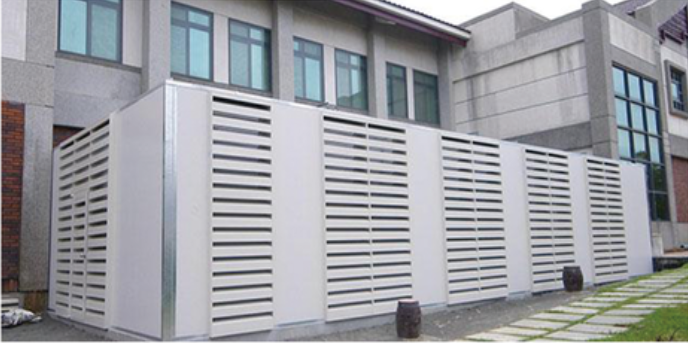
(2) Control of noise propagation pathways
For noise that cannot be controlled from the source, the impact of noise on teaching can only be controlled by increasing the sound insulation of the classroom itself to cut off the transmission path.
1. Sound insulation of doors and windows: The reason why doors and windows have poor sound insulation is because they belong to lightweight components, and their surface density is generally much smaller than that of walls.
At the same time, the gaps around doors and windows are also an important way for sound transmission. Therefore, the key to improving the sound insulation of doors and windows is the material of the doors and windows themselves and the treatment of the gaps around them. Replacing professional soundproof doors and windows can solve the problem once and for all.
According to the law of mass, doubling the surface density of components increases the sound insulation by 6dB. The design of soundproof doors should use materials of different materials stacked together, which is beneficial for reducing resonance frequency and improving sound insulation;
The door joint treatment should ensure close contact between the door and the frame, as well as between the door and the ground, without forming any gaps.
The sound insulation of windows mainly depends on the number and thickness of glass layers, as well as the sealing degree between window sashes and frames.
The more layers and thickness of glass, the larger the cavity between the glass, the higher the sound insulation, and the better the insulation performance.
Elastic material pads can be used around glass gaps to reduce vibration and noise transmission.
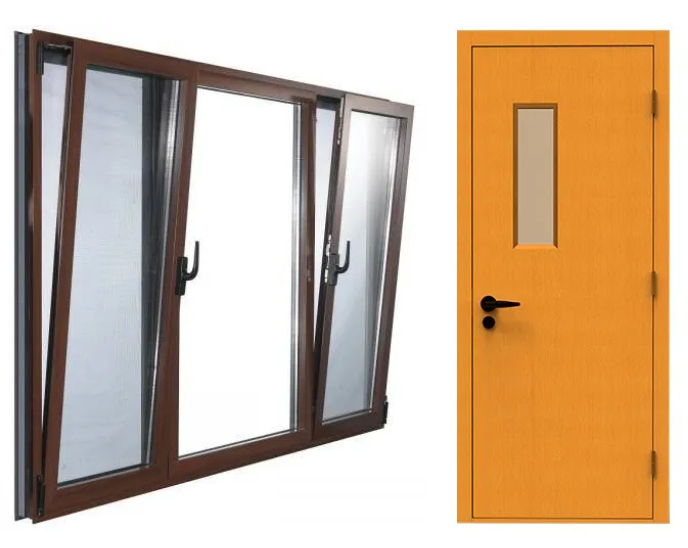
In summary, the acoustic design scheme of the classroom is an extremely important part of the educational environment, which directly affects the learning effectiveness of students and the teaching quality of teachers.
A good acoustic design scheme can effectively improve the acoustic environment of the classroom, enhance the listening effect and focus of students, and also enhance the sound transmission effect of teachers, making teaching more vivid and effective.
Therefore, in the implementation of classroom acoustic design schemes, it is necessary to fully consider the characteristics and functional requirements of the classroom, and take corresponding measures to improve the acoustic environment of the classroom to ensure smooth learning and teaching in the classroom.

Hot products
-
Micro Perforated Wood Acoustic Panel
The materials of Micro Perforated Wood Acoustic Panels are made of MDF with microperforations on the visible side and big holes in the back side.
-
Wooden Grooved Wall Panels
China's Leading Wooden Grooved Wall Panels Manufacturer - Get premium quality acoustic wood slat panels at factory-direct prices. Our FSC-certified grooved wall panels feature custom CNC designs (5-20mm depth), excellent sound absorption (NRC 0.6-0.9), and 12+ finish options. Ideal for commercial spaces, residential interiors, and acoustic treatment. ISO 9001 certified with 15+ years experience. MOQ 100㎡ with free samples available. OEM/ODM services supported. Contact us today for wholesale pricing from China's trusted wood wall panel supplier!
-
Wall And Ceiling Acoustic Perforated Wood Panels
Premium grade perforated wood acoustic panels for wall and ceiling applications. Achieve 0.90 NRC with Class A fire-rated natural wood panels. Custom patterns & finishes for architectural acoustics.
-
300x300mm Hexagon Wall Panels - Soundproof Polyester Fiber Acoustic Panels for Easy Installation
Upgrade your space with our 300x300mm hexagon acoustic panels. Made from high-density polyester fiber, these soundproof wall panels effectively reduce noise and echo. Quick installation, stylish design, and premium sound absorption for offices, studios, and homes.
-
Private Soundproof Pod Booth For Office
Flexible and movable soundproof booth.the interior is equipped with polyester fiber sound-absorbing panels. It has the advantages of fire prevention, safety and stability.
-
Waterproof PVC Sound Barriers
Our sound insulation products help protect and reduce the impact of industrial noise on surrounding residents and on-site workers.We use the world's leading acoustic technology and innovative material design to provide the most effective temporary sound solutions on the market.The one of most important thing is that soundproof products can work under various conditions on any construction site.
-
Perforated Wood Acoustic Panel
Product introduction: Acoustic Wood panels is a sound-absorbing material of MDF material with many holes. It is widely used in theater, restaurant, household and other places which need to reduce noise. DIY Perforated Acoustic Panel Precautions: l Wood or melamine veneer with different colors is natural phenomenon. l Pay attention to moisture before installation. Please keep them in a dry environment.
-
Wholesale Anti-Vibration Pads
Source high-quality wholesale anti-vibration pads for machinery, construction, and OEM projects. Get competitive bulk pricing, global shipping, and custom solutions from trusted suppliers.
-
Smoked oak sound-absorbing board, black felt
As a leading Chinese acoustic panel manufacturer, our factory specializes in producing Akupanel wooden slat acoustic panels that combine aesthetic appeal with superior noise reduction performance. These wood wall acoustic panels are ISO 9001 certified, featuring Class A fire ratings and NRC 0.85 sound absorption coefficients.
-
Standard 9 mm PET Felt panels
Discover customizable acoustic wall panels made from 100% recycled PET polyester fiber. Achieve NRC 0.85+ sound absorption with eco-safe (12 bottles recycled/panel), fire-resistant (Class A/B1) solutions. Perfect for studios, offices & modern interiors. Custom sizes/colors available. LEED & GREENGUARD Gold certified.
-
20mm polyster fiber panel directly supplied by Chinese manufacturers
PET Acoustic Panel is made from 100% polyester,by needle punching processing. The production processis completely physical&eco-friendly, no waste water,emissions, waste. no adhesive, The porous nature ofacoustic panel makes it sound absorptive&thermalinsulative.
-
Modern Office Meeting Pods - 2 Steel Walls + 2 Glass Walls - Custom Sizes Available
China factory-direct manufacturer of premium soundproof meeting pods featuring 2 metal walls + 2 glass walls. Our ISO-certified office pods deliver 38dB noise reduction with quick-ship modular designs. Custom sizes/colors available with 5-year warranty. Ideal for offices, coworking spaces & universities. Competitive pricing with bulk order discounts. Request CAD files & quotes today!
-
Polyester Acoustic Panel (standard)
High-performance polyester fiber acoustic panels for noise control and sound absorption. Eco-friendly soundproofing solution for commercial and residential spaces with Class A fire rating.
-
24mm PET Acoustic Panels Polyester Fiber Sound Absorbing Material
Our 24mm PET Acoustic Panel answers your acoustical and aesthetic needs with its strong sound-absorbing performance, durability, and elegant appearance. These panels are used for sound reduction and reverberation control. Available in a wide variety of sizes, thicknesses, fabric styles, and colors. 24mm PET Acoustic Panels allow you to create an effective sound control treatment that is distinctly appropriate for your environment.
-
Premium Decorative Natural Grooved Akupanel Wooden Acoustic Panels – Direct from China Manufacturer
As a leading China-based acoustic panel factory, we specialize in crafting high-quality Decorative Natural Grooved Akupanel Wooden Acoustic Wall Panels that combine aesthetic appeal with superior sound absorption. Our products are engineered for architects, interior designers, and contractors seeking eco-friendly acoustic solutions with customizable designs.
-
Sound Insulation Wood Wool Acoustic Panel
Wood fiber acoustic board is a decoration and sound insulation material, using pure wood wool as raw material which is characterized by available for a variety of colors and patterns to choose from, the finishes color can be adjusted according to the requirements of the acoustic renovation or investors; wool wood acoustic panel sound absorption spectrum is high, which have fairly good results for low, medium and high frequency noises, and good fire-proof, no dust pollution, strong decorative and simple to use. There are many specification levels available for investors to choose, you can simply note when ordering.
Cases
-
Acoustic Decoration Project for Lecture Hall - Nanhai Middle School Renovation and Expansion Project
The original acoustic design of the auditorium at Nanhai Middle School can no longer meet the needs of modern teaching and activities, especially in large-scale lectures, conferences, and cultural events. The uniformity of the sound field and the clarity of speech directly affect the efficiency of information transmission and learning outcomes. Therefore, carrying out scientific and reasonable acoustic decoration is the top priority of current work.
-
Shenzhen Longhua Experimental School Concert Hall
Shenzhen Longhua Experimental School Concert Hall
-
Songshan Lake Taiwan Garden North School - Classroom Acoustic Decoration Project
In the current educational environment, the acoustic design and decoration of classrooms are receiving increasing attention. A good acoustic environment can not only improve students' learning efficiency, but also provide teachers with a better teaching space. As a modern educational institution, Songshan Lake Taiwan Garden North School has realized this and therefore carried out classroom acoustic decoration projects in order to create an ideal learning and teaching environment for teachers and students.
-
Acoustic Renovation Case of Lecture Hall (Dongguan Songshan Lake School Junior High School Project) - Yuefa Acoustics
The lecture hall is not only used for hosting large-scale conferences, cultural performances, and social events, but also often serves multiple functions such as education and training, exhibitions, etc. The goal of acoustic renovation is to optimize the sound field distribution, reduce noise interference, and improve audio clarity, so that the auditorium can better adapt to various needs.
-
Acoustic architectural decoration of the multifunctional hall at Xinyu Ninth Middle School
Yuefa Acoustics provides professional multifunctional hall acoustic decoration design solutions, including architectural acoustics, sound reinforcement, and noise control design, with the aim of ensuring language clarity in the audience seats.
-
Acoustic Decoration Project of Guangzhou Metro Museum
Acoustic Decoration Project of Guangzhou Metro Museum
-
Nanhai Middle School Lecture Hall
The original acoustic design of the auditorium at Nanhai Middle School can no longer meet the needs of modern teaching and activities, especially in large-scale lectures, conferences, and cultural events. The uniformity of the sound field and the clarity of speech directly affect the efficiency of information transmission and learning outcomes. Therefore, carrying out scientific and reasonable acoustic decoration is the top priority of current work.
Online Service



